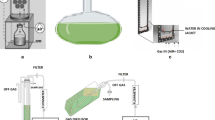Abstract
Chlorobium limicola UdG 6038, a green sulfur bacterium, was isolated from anoxic sediments. Cells were gram-negative, non-motile, ovoid shaped, and contained chlorobactene and bacteriochlorophyll c as the main photosynthetic pigments. The DNA G+C content was 56.4 mol%. Ultrastructural studies revealed the presence of abundant spinae (45–110 spinae per cell) attached to the cell wall. India-ink-stained cells observed under the optical microscope were surrounded by a large capsule (5–11 μm total diameter). The presence of this capsule was coincident with the presence of a large number of spinae (> 30 spinae per cell). The mucilaginous capsule was attached to the spinae without penetrating it. In batch culture, the synthesis of spinae in strain UdG 6038 was not affected by changes in temperature, pH, salt concentration, or illumination at physiological ranges and hence, the cells remained spined. The control of spinae production was experimentally confirmed using a semicontinuous batch culture refed by sulfide pulsing. The culture remained at a low spination level (> 30 spinae per cell) only when the duration of sulfide starvation between pulses was less than 5 h. After longer sulfide starvation periods, the cells remained spined (more than 38 ± 6.3 spinae per cell). This observation supports the idea that the duration of sulfide limitation in the culture plays a key role in controlling the spination process in strain C. limicola UdG 6038. Chlorobium spinae may play an eco-physiological role in buoyancy capacity and adhesion of sulfur globules to the cells in natural environments where sulfide concentrations are expected to be highly variable.
Similar content being viewed by others
Author information
Authors and Affiliations
Additional information
Revision received: 13 November 1995 / Accepted: 19 January 1996
Rights and permissions
About this article
Cite this article
Pibernat, I., Abella, C. Sulfide pulsing as the controlling factor of spinae production in Chlorobium limicola strain UdG 6038. Arch Microbiol 165, 272–278 (1996). https://doi.org/10.1007/s002030050326
Issue Date:
DOI: https://doi.org/10.1007/s002030050326




